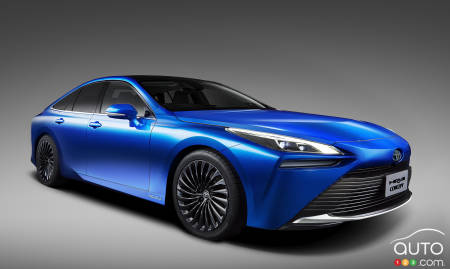As new electrified vehicles continue to sprout on the automotive landscape, it’s understandable that people wonder what else fuel-cell technology can really bring to the table, either on a global scale or closer to home here in Canada.
And yet, there are at present at least three big automakers with hydrogen-powered vehicles on their roster, somewhere. Honda has the fuel-cell version of its Clarity (found only in select American states), while Hyundai has its Nexo utility model available in Canada. And then there’s Toyota, which has been selling the Mirai in Japan since 2016, and in Quebec since 2018. Most recently, since July of this year to be exact, British Columbians can now also acquire a Mirai.
Needless to say, I was eager to try out the Mirai for a short stint courtesy Toyota Canada; exceptionally, I was to pick up the car at the company’s regional HQ in a suburb of Montreal. The reason for that is simple: hydrogen might be the most abundant element found in the universe, but it’s still exceedingly difficult to find from a commercial pump. In fact, even the refilling pump located at the automaker’s local offices is temporary, which helps explain why my tester’s range between visits for a top-up was a mere 250 km. No matter, I was happy to try out one of the oddest cars to travel on a Canadian road in 2019.
.jpg?scaledown=450)
How does a hydrogen fuel-cell car work?
Before we get into the meat of the test drive, it’s worth taking a moment to understand how a futuristic system like this works in a vehicle (the word Mirai means “future” in Japanese). The basis of the system is in fact an electric motor, which helps deliver an output of 151 hp and 247 lb-ft of torque, sent to the front wheels. This of course explains the extreme quiet of the motor when starting up or leaving a stop.
Though the motor is fed by a nickel-metal hydride (Ni-MH) battery (notably for starting up and to support more-muscular accelerations), another set of batteries – this one of the fuel-cell kind – takes over as soon as startup is completed. In case you were wondering, you don’t feel any of the transition when at the wheel.
In these fuel-cell batteries, lodged under the floor of the car, there’s a chemical reaction between the oxygen delivered via front air vents and the hydrogen housed in two fuel tanks. One of these is installed under the rear bench of seats, the other behind the bench. You can imagine how this directly impacts the trunk space available for placing cargo, and also prevents lowering the bench for fitting in longer objects.
.jpg?scaledown=450)
The chemical reaction between the oxygen and the hydrogen is what produces the electricity required to “drive’ the electric motor. And as it is an electric system, the transmission is of one single speed.
About range
I should devote a moment to the theoretical range of the car, which, to my surprise, was listed as just 184 km on my departure from Toyota HQ. I had been promised 250 km, but it turns out those temporary stations can only fill up the tanks halfway. Sure enough, the screen on the top of the dashboard indicated a battery half-charged. And yet, at the same time, the range showed 184 km.
I sought clarification from Patrick Ryan, Toyota’s regional head of sales, who explained that the onboard computer kept in memory the type of driving done by previous drivers. In other words, this Mirai I was in, which had under 3,000 km on its odometer, had already been driven by several different drivers, each with their own driving behaviour. From this I deduced that some of those drivers (most of them automotive journalists) drove with lead feet. A shocking revelation…
.jpg?scaledown=450)
A puzzling design and a “Priustic” interior
As a rule I try to stay away from dwelling too much on the outer design of a vehicle – tastes are so subjective, after all – but occasionally I let loose. My mandate is not to tear into the designers of cars, and not in this case of the Mirai. No doubt those who came up with it had to find a way to draw attention to it while satisfying the many and strict requirements that such a powertrain entails.
Honestly, take away the huge lettering on its side advertising its uniqueness, and the Mirai could go totally unnoticed in traffic. In fact, the car looks somewhat like a Prius, though with a more vertical aspect and with that notable separation between the hood and the front wings. Despite that, Toyota’s Mirai does manage a generally “green car” look that will please those adventurous enough to acquire one now during the infancy of the fuel-cell genre.
The Mirai’s creators also wanted to reward those curious enough to come take a close look with an appealing interior, and they chose to fashion one that approximates very closely what you get in a Prius. The interweaving curves, the asymmetrical screen, the transmission lever similar to the hybrid’s, even the large data screen mounted higher up on the dashboard are all very close to what the Prius has.
.jpg?scaledown=450)
The other touchscreen between the two front-row occupants, for the climate control system, is very modern, but as I always feel obliged to mention, this technology forces the driver’s eyes off the road when it’s time to adjust the interior temperature. It’s attractive and it’s easy to clean, but it’s just not as intuitive as a series of buttons.
The Toyota Mirai is a high-sitting car, and it feels that way inside. The seats are of a height that makes you feel you’re in a crossover. You slide into the car, not descend into it, and once there you’re sitting on very soft seats that hint at the kind of drive Toyota wanted to deliver with its fuel-cell car.
In back, the central armrest precludes squeezing a third passenger in, but the upside is it provides natural separation if you have two kids back there. The armrest also contains controls for the heated seats and a bit of extra storage space.
The verdict… at the wheel
And how does the Mirai actually drive? The word that comes to mind is “tranquility”. The car seeks very hard to deliver a comfortable and quiet ride. Of course the electric powertrain produces almost no noise at all, though I found the zen stillness disturbed somewhat when accelerating hard, because the air compressor has to work a little harder to carry oxygen to the back to make the chemical reaction happen.
.jpg?scaledown=450)
For the rest, the drive delivered by the Mirai is able and competent. There’s a bit of roll when cornering and the soft suspension means the front end dips heavily down when braking hard. To be fair, of course, the Mirai wasn’t designed to lay down terrific lap times on the track; it’s mandate is of a whole other nature!
With 151 hp at its disposal, the Toyota Mirai is no galloping steed on acceleration, especially since at 1,850 lb it’s a very heavy beast. Fortunately, the healthy torque helps it do a passable job of passing on the highway. The steering is very light (and even a bit shaky), but in the city at slow speed, the Mirai is a very easy car to handle. I would have been shocked to discover otherwise…
The last word
The Mirai has been available in Quebec since the spring and in B.C. since July, but only as part of commercial fleets. The current lack of sufficient infrastructure makes private ownership and use too complicated right now. As expected, this vehicle that carries expensive new technologies is, well, expensive. Listed price? $73,870.
.jpg?scaledown=450)
I think it’s still too early to gauge the staying power of hydrogen fuel-cell powertrains. For now, electric vehicles are far ahead in the clean-car segment. Still though, consider that you can drink straight from the exhaust tip the only emissions produced by the Mirai. (And that is what the small H2O button inside the car is for, when you need to drain the system after a drive!).
By the way, Toyota has just revealed the concept version for its next-gen Mirai car, and it’s clear the automaker decided the non-descript appearance of the current edition had to go. Here’s a first look at the sleek, coupe-like, RWD next Mirai, set to hit the market in late 2020.

We like
Its innovative aspect
Water is the only emissions produced!
Quiet, smooth ride
We like less
The design’s not particularly daring
No refueling infrastructure to speak of
The competition
None
.jpg?scaledown=450)
.jpg?scaledown=450)
.jpg?scaledown=450)
.jpg?scaledown=450)
.jpg?scaledown=450)


fr.jpg?scaledown=450)
